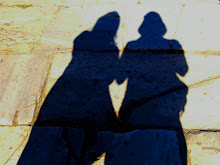
December 14, 2007
N49°21.551
W000°51.197
It was another cold winter morning; our breath made large clouds of smoke in front of our faces and frost covered everything in site. Inside the car we were nice and warm, but the temperature outside oscillated between -2 and 1 Celsius. We knew it would be really cold at our destination,
We pulled into the nearly empty parking lot of the
As we walked out toward the cemetery, I looked down upon
 The boats were designed to unload equipment quickly by dropping a large ramp in the front of the boat. The plan was to get close enough to shore to unload hundreds of thousands of men, tanks and equipment, circle back, and get more of everything to quickly unload. However, the tide was rough that day; the captains of the Higgins Boats couldn’t get close enough as Germans were shooting at them from above, from the exact area where I am standing today. From my vantage point it was clear that anyone on the beach that day would have been an easy target.
The boats were designed to unload equipment quickly by dropping a large ramp in the front of the boat. The plan was to get close enough to shore to unload hundreds of thousands of men, tanks and equipment, circle back, and get more of everything to quickly unload. However, the tide was rough that day; the captains of the Higgins Boats couldn’t get close enough as Germans were shooting at them from above, from the exact area where I am standing today. From my vantage point it was clear that anyone on the beach that day would have been an easy target.
For Operation Overlord (code name for D-Day) to be successful, there had to be an element of surprise. The Germans felt the beaches of
The rough waters prevented several of the boats from getting close enough to shore for the ramps to work properly. The ramps were lowered, men jumped out, only to find themselves underwater with 90 pounds of equipment on their backs. They had two choices at this point—cut off the pack or drown. Unfortunately, for some, they couldn’t think fast enough and they simply perished before they reached the beach.
The boats that did make it closer had to avoid booby traps created by the Germans. Most of the traps were underwater mines; exploding and killing entire ships of men. The greatly important
traps were underwater mines; exploding and killing entire ships of men. The greatly important
At
We walked across the lawn, reading several of the names, ranks, home states; many perishing in June and July of 1944. I read the names aloud, no one else around to hear, I wondered when the last time anyone uttered their names. Robert Scott, Ruel Sanford, Jimmie Monteith. When was the last time someone thought about these men? Who were their families, who were their friends, what did they imagine they would grow up to be? Most importantly… will they be remembered in another 60 years?
With our faces frozen, our noses running and hands numb, we headed back to the Visitor’s Center. The center shows short movies commemorating some of the men who fought that infamous day. One of the men turned down a promotion to stay in the front line with his comrades; another, a surgeon, asked for a transfer from a safe hospital to care for the injured on the front line, never telling his wife who was home with two kids; and one more, a pilot from Ceres, CA who thought he was invincible after fighting in North Africa and Sicily.
As we walked through the cemetery, we saw a group of French students on a field trip. The teenagers, acting like teenagers, ran through the cemetery, snapped pictures and somewhat listened to their teacher. We wondered if these kids really understand the significance of what the Americans and Allied Forces did for their country 63 years ago, or do they only know the
“To those we owe the high resolve that the cause for which they died shall live.”


1 comment:
In the words of Vince Vaughn, Yeah... we lost a lot of good men that day.
Damn frenchies need to teach those high school kids some respect.
Post a Comment